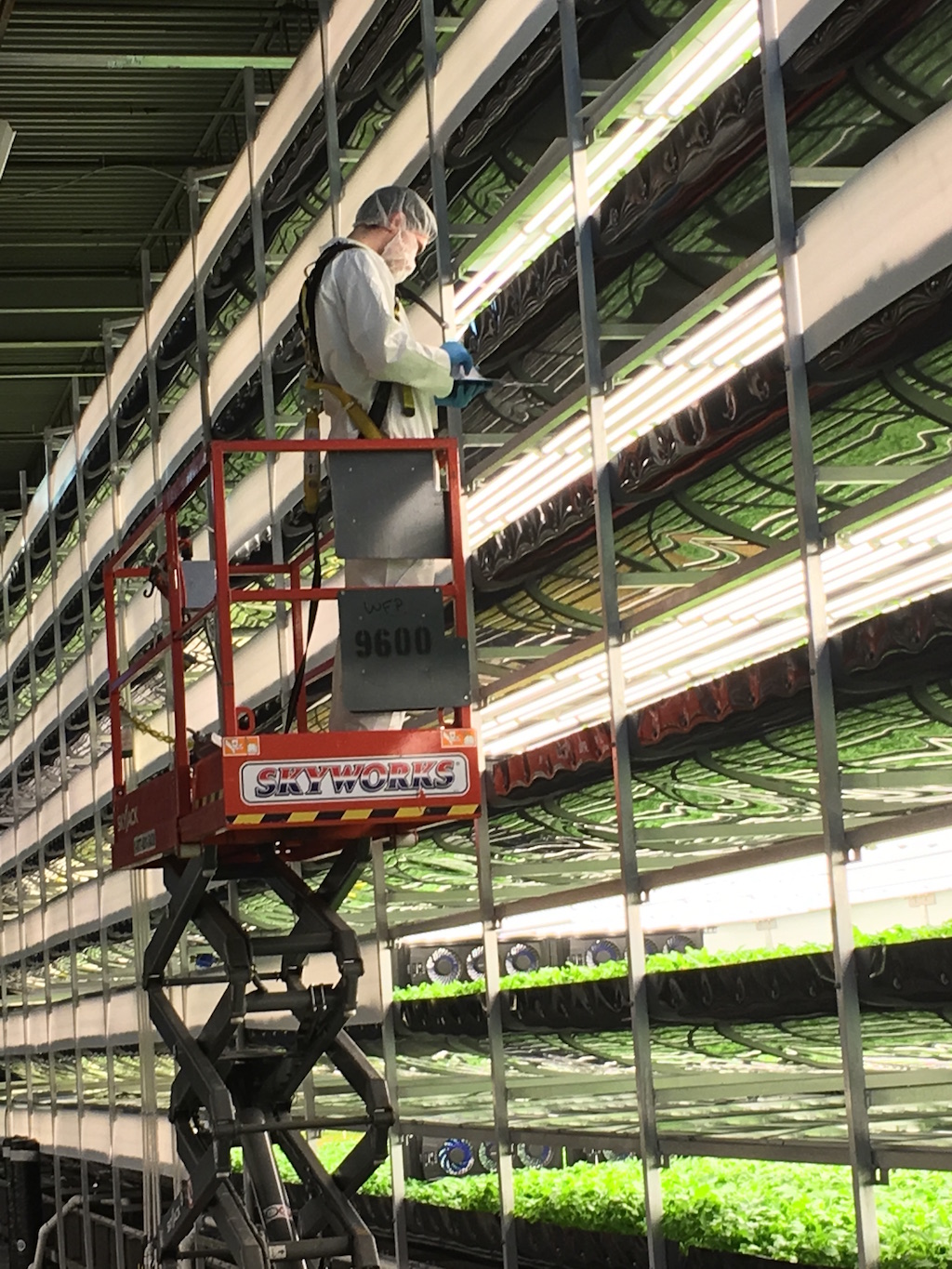Vertical Farming, Continued
This is page 3 of our nine page series on hydroponic vertical farming. Click any of the below pages to jump to that page.
Page 1 Page 2 Page 3 Page 4 Page 5 Page 6 Page 7 Page 8 Page 9

A worker at Aero Farm tends to the crops. The scissor lift pictured here is how many people envision gaining access to multiple stacks of growing trays. However, scissor lifts bring with them a variety of problems and additional complications. Human access is just one of the issues faced by vertical farming. Photo courtesy of Aero Farms, a vertical farming venture with multiple locations; the company is based in New Jersey. They have succeeded where other similar ventures have failed. Visit www.aerofarms.com for more information on their business, research and latest developments.
Vertical Farming Disadvantages
Before we fall head over heels in love with this approach, let’s take a moment to look at those commercial ventures which failed. What went wrong? Simply put, the vertical farming approach worked well in terms of growing a lot of plants in a small space. By itself that would have keep those businesses in profits for the foreseeable future. However, the vertical farming approach created a lot of unexpected issues with human access to those plants. That might seem like a minor detail, but it impacted every phase of the operation. For instance, consider the case of growing lettuce in trays which were stacked 12’ high. The trays which were closest to the ground were relatively easy to work with for the people who tended them. The employees could reach the trays to plant, cultivate, prune and harvest the plants, then prep the trays for a new crop. The near-ground-level trays could also be inspected and repaired when irrigation blockages or leaks occurred, and parts needed to be cleaned or replaced. But as the trays increased in height above 4’, all the difficulties increased. Employees needed to use ladders, scissor lifts, bucket lifts or some other contraption to go up and down the stack to reach the higher plants and trays. That took time and energy; enough time and energy that any cost savings created by the intensive crop production, was spent on labor instead. In the end, the businesses failed due to those costs. Bottom line, the businesses could not capture the benefits of the ultra-efficient space utilization, because the labor costs were so much higher than conventional ground-level production.
Sadly, there are other disadvantages. Let’s assume for a moment that the human labor issue could be resolved in some way. What other issues did they experience? Stacks of growing trays create enormous weight loads. The racks which hold the trays, and the flooring which supports the racks, all need to be extremely rugged. That comes at a much higher cost than conventional ground-level hydroponic infrastructure.
Secondly, whatever irrigation method is used for the growing beds or trays must be strong enough to reach those higher levels. That means bigger pumps, bigger irrigation lines, and more durable plumbing fixtures at each level. That adds to the cost as well. Any wastewater created by the system (and that quantity will vary depending on which irrigation system is used) will require plumbing out to some dedicated wastewater handling system. In rural areas, wastewater can be sprayed on outdoor crops or even onto the natural landscape. In urban areas, the volumes of wastewater generated by anything larger than a small hobby system may require a formal sewer line tie-in, along with all the permits and costs that entails.
Third, the trays are generally stacked as closely as possible, allowing only enough space between trays for the growing plants. In addition, any given vertical farming installation will probably include more than one rack of trays. Each subsequent rack essentially creates a wall with very little light penetrating through the small gaps between the top of the plants and the next higher tray. What does this mean? Each of those trays will cast a shadow which blocks light to the nearby trays. The uppermost trays will get suitable light if the racks are in a greenhouse, but a standard building won’t have enough light even for the top trays. Standard ceiling-mounted lights won’t be sufficient for the lower trays. As a result, each tray must have its own light source, typically attached to the bottom of the tray above it. This adds not only acquisition cost, but also additional energy costs over time.
This is page 3 of our nine page series on hydroponic vertical farming. Click any of the below pages to jump to that page.
Page 1 Page 2 Page 3 Page 4 Page 5 Page 6 Page 7 Page 8 Page 9